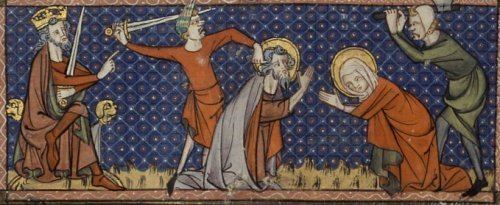Died c. 283
Rome Canonized Pre-Congregation | Name Saints and | |
 | ||
Venerated in Coptic Orthodox Church
Eastern Orthodox Churches
Oriental Orthodox Churches
Roman Catholic Church Feast October 25 (Western Christianity)
March 19 (Eastern Christianity) | ||
Saints Daria and Chrysanthus
Saints Chrysanthus and Daria (3rd century – c. 283) are saints of the Early Christian period. Their names appear in the Martyrologium Hieronymianum, an early martyr's list, and a church was built in their honour over their reputed burial place in Rome.
Contents
Legend
Acts of the Martyrs relating the legend of Chrysanthus and Daria exist in a Greek and in Latin versions, dating from the fifth century and all "without historical value", according to the Catholic Encyclopedia.
According to legend, Chrysanthus was the only son of an Egyptian patrician, named Polemius or Poleon, who lived during the reign of Numerian. His father moved from Alexandria to Rome. Chrysanthus was educated in the finest manner of the era. Disenchanted with the excess in the Roman world, he began reading the Acts of the Apostles.
He was then baptized and educated in Christian thinking by a priest named Carpophorus. His father was unhappy with Chrysanthus's conversion and attempted to inculcate secular ways into his son by tempting him with prostitutes, but Chrysanthus retained his virginity.
He objected when his father arranged a marriage to Daria, a Roman Vestal Virgin. Chrysanthus converted his new bride and convinced her to live with him in a chaste state. Vestal Virgins took a vow of chastity during their thirty-year term of service.
They went on to convert a number of Romans. When this illegal act was made known to Claudius, the tribune, Chrysanthus was arrested and tortured. Chrysanthus's faith and fortitude under torture were so impressive to Claudius that he and his wife, Hilaria, two sons named Maurus and Jason, and seventy of his soldiers became Christians. For this betrayal, the emperor had Claudius drowned, his sons beheaded and his wife went to the gallows. The legend states that Daria was sent to live as a prostitute, but her chastity was defended by a lioness. She was brought before Numerian and ordered to be executed. There are many variations to this legend. Some claim that she was subjected to execution by stoning, others say she was beheaded and yet others claim she was buried alive in a deep pit beside her husband. They were entombed in a sand pit near the Via Salaria Nova, the catacombs in Rome.
The surviving "Acts" of Chrysanthus and Daria state that on the anniversary of their deaths, a large number of Christians had gathered at their underground crypt to pay their respects when Roman persecutors surprised them, filled the crypt with stones and buried them all alive, including Diodorus, a priest, and Marianus, a deacon.
Relics
At least three places claim to possess the remains of Saints Chrysanthus and Daria. In the 9th century, their reputed remains were brought to Prüm in modern-day Rhineland-Palatinate, and these relics are presently in the church of Chrysanthus and Daria, Bad Münstereifel, Germany. In 1011, Pope Sergius IV gave Fulk Nerra, Count of Anjou, the reputed bodies of Chrysanthus and Daria upon his return from a pilgrimage to Jerusalem. Fulk gave them to the monastery of Belli Locus which he had recently established. The cathedral of Reggio Emilia, north Italy, also contains relics reputed to be those of Daria and Chrysanthus. A scientific study of some of the bones there confirmed that they were those of a young man and a young woman in their late teens, with a radiocarbon date between AD 80 and AD 340.
